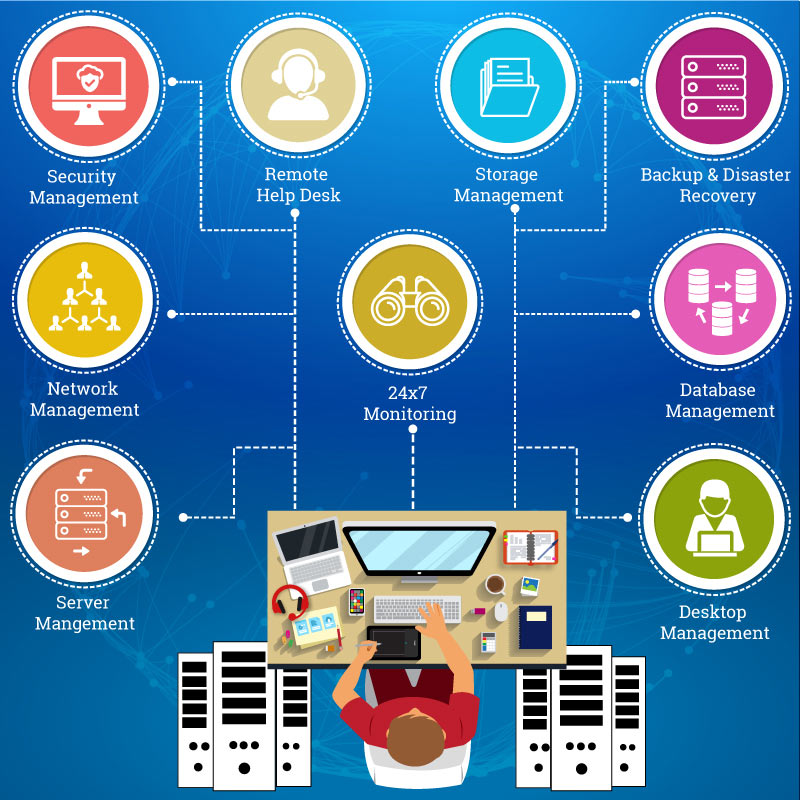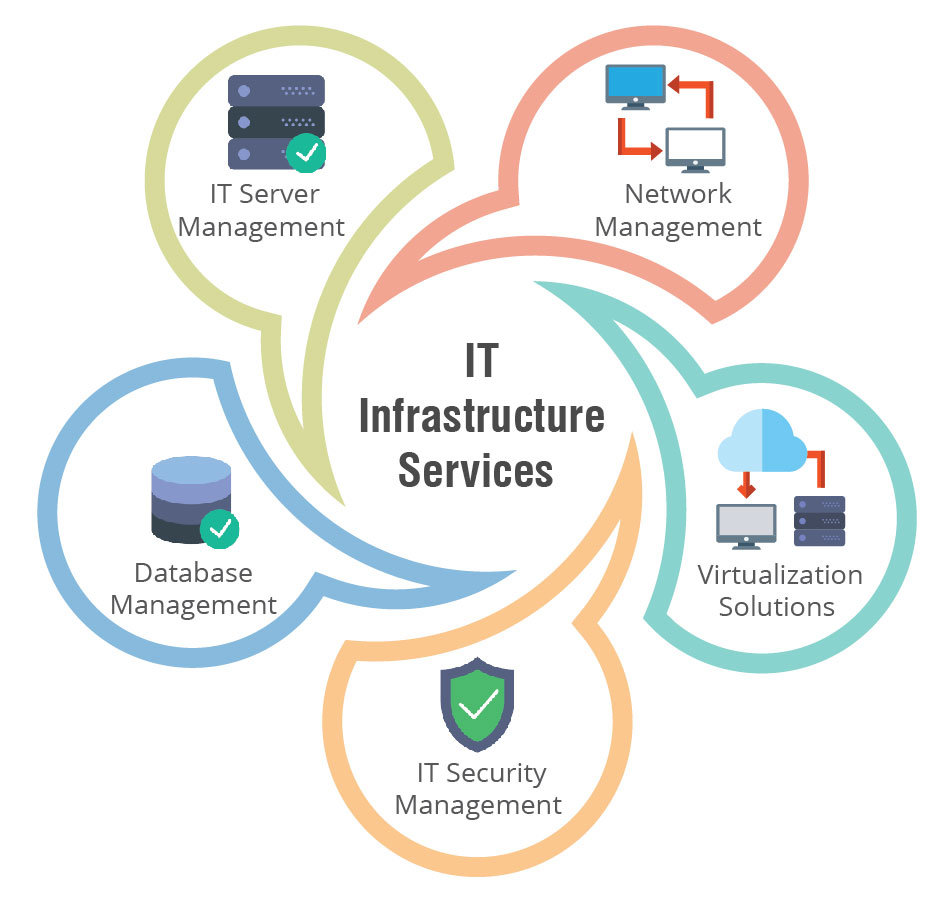The Role of Flexible IT Infrastructure in Business Success
A scalable IT infrastructure is a critical component for businesses seeking long-term growth, cost efficiency, and resource optimization. By definition, scalable IT infrastructure solutions for enterprises are designed to adapt and expand with the organization’s needs, ensuring seamless integration of new technologies and applications.
Scalability goes beyond merely accommodating growth; it also involves managing resource utilization and reducing operational costs. A flexible IT infrastructure allows businesses to allocate resources dynamically, ensuring optimal performance during peak usage periods while minimizing waste during off-peak times. This agility contributes significantly to cost savings and improved operational efficiency.
Moreover, a scalable IT infrastructure facilitates digital transformation initiatives by enabling the integration of emerging technologies such as artificial intelligence, machine learning, and the Internet of Things (IoT). By providing a solid foundation for innovation, businesses can stay ahead of the competition and capitalize on new market opportunities.
In summary, a scalable IT infrastructure is essential for businesses aiming to achieve sustainable growth and maintain a competitive edge. By investing in adaptable and dynamic IT infrastructure solutions, enterprises can reap the benefits of cost efficiency, resource optimization, and seamless integration of cutting-edge technologies.
Key Components of a Dynamic IT Infrastructure
A dynamic IT infrastructure is the backbone of a scalable and adaptable enterprise. It comprises several essential elements, including cloud computing, virtualization, automation, and AI-driven management tools. These components work together to provide a robust and flexible foundation for business growth and innovation.
Cloud Computing
Cloud computing enables on-demand access to computing resources, allowing businesses to scale their IT infrastructure according to their needs. By leveraging cloud services, enterprises can reduce capital expenditures, increase operational efficiency, and improve collaboration among teams.
Virtualization
Virtualization technology allows businesses to create multiple virtual environments on a single physical server, optimizing resource utilization and reducing hardware costs. This approach also simplifies disaster recovery and enables seamless migration of workloads between different infrastructure components.
Automation
Automation tools streamline IT operations by reducing manual intervention and minimizing human errors. These tools can handle repetitive tasks, monitor system performance, and trigger alerts when issues arise, ensuring consistent and reliable service delivery.
AI-Driven Management Tools
AI-driven management tools leverage machine learning algorithms and predictive analytics to optimize IT infrastructure performance and scalability. These tools can identify patterns, predict trends, and recommend proactive actions to ensure seamless operations and minimize downtime.
In conclusion, a dynamic IT infrastructure is critical for businesses aiming to achieve long-term growth and cost efficiency. By incorporating cloud computing, virtualization, automation, and AI-driven management tools, enterprises can build a scalable and adaptable IT infrastructure that supports their digital transformation initiatives and competitive edge.

Designing a Scalable IT Infrastructure Strategy
A well-designed scalable IT infrastructure strategy is essential for businesses seeking long-term growth, cost efficiency, and resource optimization. This strategy comprises several stages, including assessment, planning, migration, and monitoring. By following a step-by-step process, enterprises can build a robust and adaptable IT infrastructure that supports their digital transformation initiatives and competitive edge.
Assessment
The first stage in designing a scalable IT infrastructure strategy is to assess the current state of the enterprise’s IT environment. This involves evaluating the existing hardware, software, and network infrastructure, as well as identifying any bottlenecks, limitations, or inefficiencies. The assessment should also consider the business’s growth projections, digital transformation goals, and security requirements.
Planning
Based on the assessment findings, the planning stage involves defining the architecture, components, and roadmap for the new scalable IT infrastructure. This may include selecting the appropriate cloud computing platform, virtualization technology, automation tools, and AI-driven management systems. The planning stage should also consider cost management strategies, such as budgeting, forecasting, and chargeback models.
Migration
The migration stage involves deploying the new scalable IT infrastructure and transferring the existing workloads and data to the new environment. This may involve several activities, such as configuring the cloud services, setting up the virtual machines, and testing the applications and services. The migration should be performed in a phased manner, minimizing the impact on the business operations and ensuring data integrity and security.
Monitoring
The final stage in designing a scalable IT infrastructure strategy is to establish a monitoring and management framework that ensures the ongoing performance, availability, and security of the IT infrastructure. This may involve setting up the monitoring tools, defining the alert thresholds, and establishing the incident response procedures. The monitoring stage should also include regular performance reviews, capacity planning, and optimization activities.
In conclusion, designing a scalable IT infrastructure strategy is a critical success factor for businesses aiming to achieve long-term growth and cost efficiency. By following a step-by-step process that covers assessment, planning, migration, and monitoring stages, enterprises can build a robust and adaptable IT infrastructure that supports their digital transformation initiatives and competitive edge.

Selecting the Ideal Scalable IT Infrastructure Solution
Selecting the ideal scalable IT infrastructure solution is a critical decision for enterprises seeking long-term growth, cost efficiency, and resource optimization. With a multitude of options available, businesses must consider several factors to ensure that the chosen solution aligns with their unique needs, budget, and security requirements.
Business Needs
The first factor to consider when selecting a scalable IT infrastructure solution is the enterprise’s specific business needs. This includes evaluating the current and future workload requirements, application and data dependencies, and user experience expectations. The chosen solution should be able to support the enterprise’s digital transformation initiatives, such as cloud adoption, big data analytics, and AI-driven automation.
Budget
The cost of implementing and maintaining a scalable IT infrastructure solution is another critical factor to consider. Enterprises must evaluate the upfront investment, ongoing operational expenses, and total cost of ownership (TCO) of the solution. The chosen solution should provide a good balance between cost and value, offering the required features and capabilities at a reasonable price point.
Security Requirements
Security is a paramount concern for enterprises when selecting a scalable IT infrastructure solution. The chosen solution should provide robust data protection, access control, and incident response capabilities. The solution should also comply with relevant industry standards and regulations, such as GDPR, HIPAA, and PCI-DSS.
Popular Scalable IT Infrastructure Solutions
Some of the popular scalable IT infrastructure solutions for enterprises include Amazon Web Services (AWS), Microsoft Azure, Google Cloud Platform (GCP), and IBM Cloud. These solutions offer a wide range of features and capabilities, such as virtual machines, containers, serverless architectures, and AI-driven analytics. Enterprises should compare these solutions based on their specific needs, budget, and security requirements.
In conclusion, selecting the ideal scalable IT infrastructure solution is a critical decision for enterprises seeking long-term growth, cost efficiency, and resource optimization. By considering factors such as business needs, budget, and security requirements, enterprises can choose a solution that aligns with their unique requirements and supports their digital transformation initiatives.

Reviewing Top Scalable IT Infrastructure Solutions for Enterprises
Scalable IT infrastructure solutions for enterprises are essential for achieving long-term business growth, cost efficiency, and resource optimization. With a variety of options available, it is crucial for businesses to compare and evaluate the top solutions to determine which one best fits their unique needs and requirements. This article will review and compare the key features and benefits of Amazon Web Services (AWS), Microsoft Azure, Google Cloud Platform (GCP), and IBM Cloud.
Amazon Web Services (AWS)
Amazon Web Services (AWS) is a comprehensive cloud computing platform that offers a wide range of services and tools for businesses of all sizes. With over 200 fully-featured services, AWS provides solutions for computing, storage, databases, analytics, machine learning, and more. AWS is known for its scalability, reliability, and security features, making it a popular choice for enterprises seeking a robust and flexible IT infrastructure solution.
Microsoft Azure
Microsoft Azure is a cloud computing platform that offers a wide range of services and tools for businesses, including computing, storage, networking, analytics, and machine learning. Azure is integrated with Microsoft’s existing software and tools, such as Office 365 and Dynamics 365, making it an ideal solution for businesses that already use Microsoft products. Azure is also known for its hybrid cloud capabilities, allowing businesses to seamlessly integrate their on-premises and cloud environments.
Google Cloud Platform (GCP)
Google Cloud Platform (GCP) is a cloud computing platform that offers a wide range of services and tools for businesses, including computing, storage, networking, analytics, and machine learning. GCP is known for its powerful data analytics and machine learning capabilities, as well as its commitment to open-source technologies. GCP also offers a unique pricing model, with per-second billing and sustained use discounts, making it a cost-effective solution for businesses with fluctuating workloads.
IBM Cloud
IBM Cloud is a cloud computing platform that offers a wide range of services and tools for businesses, including computing, storage, networking, analytics, and machine learning. IBM Cloud is unique in its focus on artificial intelligence (AI) and cognitive computing, with tools such as Watson Assistant and Watson Analytics. IBM Cloud also offers a wide range of security and compliance features, making it an ideal solution for businesses in regulated industries.
Comparison and Conclusion
When comparing the top scalable IT infrastructure solutions for enterprises, businesses should consider their unique needs, budget, and security requirements. AWS, Azure, GCP, and IBM Cloud all offer a wide range of services and tools, with varying levels of scalability, reliability, and security. Ultimately, the best solution will depend on the specific needs and requirements of the business.
In conclusion, scalable IT infrastructure solutions for enterprises are essential for achieving long-term business growth, cost efficiency, and resource optimization. By reviewing and comparing the key features and benefits of Amazon Web Services (AWS), Microsoft Azure, Google Cloud Platform (GCP), and IBM Cloud, businesses can determine which solution best fits their unique needs and requirements.

Optimizing Scalability and Performance in IT Infrastructure
Scalability and performance are critical factors for businesses seeking to achieve long-term growth, cost efficiency, and resource optimization. A scalable IT infrastructure strategy enables businesses to adapt to changing workloads and demands, while ensuring optimal performance and reliability. In this article, we will explore best practices for optimizing scalability and performance in IT infrastructure, emphasizing the use of AI-driven analytics, automation tools, and cost management strategies.
AI-Driven Analytics
AI-driven analytics can help businesses identify trends, patterns, and anomalies in their IT infrastructure, enabling them to proactively address potential issues before they impact performance. By analyzing data from various sources, such as system logs, metrics, and events, AI-driven analytics can provide real-time insights and recommendations for optimizing scalability and performance. For example, AI-driven analytics can help businesses identify underutilized resources, such as servers or storage devices, and recommend consolidation or reallocation strategies to improve efficiency and reduce costs.
Automation Tools
Automation tools can help businesses streamline and optimize their IT infrastructure management processes, reducing manual errors and improving efficiency. By automating routine tasks, such as patching, backups, and scaling, businesses can free up resources and focus on more strategic initiatives. Automation tools can also help businesses ensure consistency and compliance across their IT infrastructure, reducing the risk of security breaches and downtime. For example, automation tools can help businesses implement best practices for access control, such as enforcing least privilege principles and implementing multi-factor authentication.
Cost Management Strategies
Cost management is a critical aspect of optimizing scalability and performance in IT infrastructure. By implementing cost management strategies, businesses can ensure that they are using their resources efficiently and effectively, reducing waste and minimizing costs. Cost management strategies can include reserved instances, spot instances, and autoscaling, which enable businesses to match their resources to their workload demands and avoid overprovisioning. Cost management tools can also provide businesses with real-time visibility into their usage and spending, enabling them to identify trends, optimize their costs, and make informed decisions.
Conclusion
Optimizing scalability and performance in IT infrastructure is essential for businesses seeking to achieve long-term growth, cost efficiency, and resource optimization. By implementing best practices, such as AI-driven analytics, automation tools, and cost management strategies, businesses can ensure that their IT infrastructure is scalable, reliable, and efficient. By investing in scalable IT infrastructure solutions for enterprises, businesses can position themselves for success in an ever-changing business landscape.

Security Best Practices for Scalable IT Infrastructure
Scalable IT infrastructure solutions for enterprises require robust security measures to protect sensitive data and maintain business continuity. Implementing best practices in data protection, access control, and incident response planning is crucial for any organization utilizing scalable IT infrastructure. This article will provide recommendations on these essential security aspects.
Data Protection
Data protection is a fundamental aspect of securing a scalable IT infrastructure. Implementing strong encryption algorithms, both at rest and in transit, ensures that data remains confidential and secure. Regularly backing up data and testing the backup process is also vital to minimize data loss risks. Additionally, implementing access control policies and monitoring user activities can help detect unauthorized access attempts and prevent data breaches.
Access Control
Access control policies should be designed to grant the least privilege necessary for users and applications. Implementing multi-factor authentication (MFA) and single sign-on (SSO) solutions can help streamline access management while maintaining a high level of security. Regularly reviewing access logs and monitoring user activities can help detect and respond to suspicious behavior promptly. Additionally, implementing role-based access control (RBAC) and attribute-based access control (ABAC) can help ensure that access is granted based on user roles and attributes, reducing the risk of unauthorized access.
Incident Response Planning
Incident response planning is crucial for any organization utilizing scalable IT infrastructure. A well-defined incident response plan should include procedures for detecting, analyzing, containing, and eradicating security incidents. Regularly testing the incident response plan and updating it based on new threats and vulnerabilities is also essential. Additionally, implementing a security information and event management (SIEM) system can help detect and respond to security incidents in real-time.
Security Compliance
Maintaining compliance with industry-specific security standards and regulations is crucial for any organization utilizing scalable IT infrastructure. Implementing a compliance management framework can help ensure that the organization remains compliant with relevant standards and regulations. Regularly auditing the IT infrastructure for compliance and addressing any gaps can help minimize the risk of security breaches and regulatory fines.
Security Awareness Training
Security awareness training is essential for any organization utilizing scalable IT infrastructure. Regularly training employees on security best practices and the importance of data protection can help reduce the risk of security breaches caused by human error. Implementing a security awareness training program that includes phishing simulations and other interactive training modules can help ensure that employees are well-equipped to identify and respond to security threats.
Emerging Trends and Innovations in Scalable IT Infrastructure
Scalable IT infrastructure solutions for enterprises are constantly evolving, with new trends and innovations emerging regularly. Staying up-to-date with these advancements is crucial for any organization looking to optimize its IT infrastructure and gain a competitive edge. This article will examine some of the most significant emerging trends and innovations in scalable IT infrastructure, including edge computing, containerization, and serverless architectures, and their potential impact on business operations.
Edge Computing
Edge computing is an emerging trend in scalable IT infrastructure that involves processing data closer to the source, rather than in a centralized data center or cloud. By reducing the amount of data that needs to be transmitted over long distances, edge computing can help improve application performance, reduce latency, and enhance data security. Edge computing is particularly useful for IoT (Internet of Things) devices, which generate large amounts of data that can be difficult to transmit and process in a centralized location.
Containerization
Containerization is a lightweight virtualization technology that allows applications to be packaged with their dependencies and run in any environment. Containerization can help improve application portability, scalability, and consistency, making it easier to deploy and manage applications in a scalable IT infrastructure. Popular containerization platforms include Docker and Kubernetes, which provide tools for managing and orchestrating containers at scale.
Serverless Architectures
Serverless architectures are a new approach to building and deploying applications that involves outsourcing infrastructure management to a cloud provider. With serverless architectures, applications are broken down into small, modular functions that are triggered by events, such as user requests or data updates. This approach can help improve application scalability, reduce infrastructure costs, and simplify application development and deployment. Popular serverless architecture platforms include AWS Lambda, Azure Functions, and Google Cloud Functions.
The Future of Scalable IT Infrastructure
The future of scalable IT infrastructure is likely to be characterized by continued innovation and evolution, with new trends and technologies emerging to meet the changing needs of businesses. As organizations increasingly rely on data and applications to drive growth and innovation, the need for scalable, flexible, and secure IT infrastructure will only become more critical. By staying up-to-date with emerging trends and innovations in scalable IT infrastructure, organizations can position themselves for long-term success and competitive advantage.

